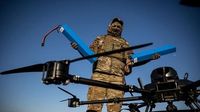Ukraine’s war against Russia, now grinding through its third year, has become a crucible for innovation, resilience, and international resolve. Early in the conflict, most observers saw Ukraine as the clear underdog—facing a nuclear-armed neighbor with a much larger economy and military. Yet, as the months have rolled by, Ukraine has not only survived but managed to frustrate Russia’s ambitions, rewrite the rules of modern warfare, and turn its defense sector into a powerhouse of technological advancement.
According to reporting by Qamar Bashir, Ukraine’s ability to adapt and Europe’s willingness to treat Kyiv’s defense as synonymous with defending the continent itself have been decisive. This political commitment rapidly translated into a torrent of money, weapons, training, and intelligence support that Moscow simply did not anticipate. The European Union’s multi-year Ukraine Facility, valued at up to €50 billion through 2027, provided predictable budget support, while total EU-level and member-state assistance across all lines has reached roughly €150 billion. That lifeline, as Bashir notes, kept the Ukrainian state and army afloat even when battlefield fortunes were uncertain.
But political will is only half the story. The other half is technological transformation—nowhere more evident than in Ukraine’s defense industry. Defense Minister Denys Shmyhal recently highlighted that Ukraine’s defense capabilities have increased 35-fold over the past three years. “Of the 900 defense sector companies, more than 800 are private,” Shmyhal stated, as reported by UBN News. The government is actively investing in human capital, urging arms producers to partner with universities and weapons labs, and to create new scholarships. The result? Over 1,000 innovative teams are now working in Ukraine’s defense sector, driving advances in everything from drones to electronic warfare.
The battlefield itself has become a proving ground for these innovations. Ukraine has industrialized a wide array of unmanned systems, including cheap FPV strike drones, long-range one-way attack drones, and uncrewed surface vessels (USVs). These tools have imposed relentless pressure on Russian logistics, airbases, and the Black Sea Fleet. Most notably, Ukraine’s use of naval drones forced Russia to pull major warships away from the strategic port of Sevastopol, weakening its ability to blockade Ukraine’s coast. Such asymmetric tactics, delivered by a country with almost no surviving navy, have had outsized strategic consequences.
Long-range precision strikes have become another cornerstone of Ukraine’s approach. In 2024, the United States transferred ATACMS missiles with a 300-kilometre range to Ukraine, opening up new options for hitting high-value targets deep behind Russian lines. These, combined with European-supplied Storm Shadow/SCALP missiles and Ukrainian-built long-range drones, have enabled a campaign targeting Russian oil infrastructure. Independent tallies indicate that, through August 2025, Ukrainian drone strikes have taken roughly 10–17% of Russia’s refining capacity offline at various points—a blow felt at Russian gas pumps and in emergency policy responses.
Yet, if this is the war of drones and strikes, it is also the war of air defense. Ukraine’s layered network—featuring Patriot, NASAMS, IRIS-T, and other systems—has rewritten what modern integrated air defenses can achieve under fire. The country has even achieved the first confirmed shoot-downs of Russia’s Kinzhal air-launched ballistic missile. In response, Russia has adapted with massed Shahed-type drones, heavy use of ballistic and cruise missiles, and powerful electronic warfare designed to saturate and degrade Ukrainian air defenses. It’s a technological arms race, with each side’s marginal gains fiercely contested.
On the economic front, Ukraine’s government is laying the groundwork for long-term resilience. Preferential loans of up to ₴100 million for working capital and ₴500 million for investment are now available to gunsmiths, with ₴2.7 billion issued so far, according to UBN News. Grants of up to ₴8 million are supporting manufacturers of drones, robotic systems, and electronic warfare equipment. The Build in Ukraine initiative enables domestic production and localization, while a new Defence City is being launched to offer a specialized legal framework for weapons manufacturers, including controlled export options. “The foundation for long-term state contracts of 3-5 years is being established,” Shmyhal emphasized, signaling a commitment to sustainable defense growth.
Western intelligence, surveillance, and reconnaissance (ISR)—including commercial satellite imagery—have also played a pivotal role. These assets have made Ukrainian strikes more precise and timely, helping compensate for Ukraine’s smaller forces. Meanwhile, Russia’s own problems have been laid bare: logistics and corruption issues have hampered its ability to keep front-line units fully equipped and to sustain complex combined-arms operations after the initial months of the war.
But the conflict has not been one-sided. Russia has adapted as well, mass-producing glide-bomb kits (UMPK) to lob heavy bombs from beyond Ukraine’s air-defense umbrellas, pulverizing defensive positions and urban strongpoints. It has scaled up Shahed-type drone production and improved missile salvos to exhaust Ukraine’s interceptor stocks, while investing in electronic warfare to blunt Ukrainian drone effectiveness. The result is a seesaw of adaptation, with each side racing to out-innovate the other.
The economic pressure on Russia is mounting. The Ukrainian refinery-strike campaign has triggered fuel shortages and rationing in some Russian regions, forcing the Kremlin to implement ad-hoc controls and export bans. Lower oil and gas revenues this summer, combined with high nominal interest rates, have further squeezed Moscow’s budget. While these pressures don’t guarantee a Russian collapse, they do narrow the Kremlin’s options as the war drags on.
Diplomacy remains elusive. President Trump attempted to open talks with Moscow in mid-August 2025, but no deal was reached, and the fighting only intensified afterward. Washington continues to weigh sanctions, export-control tightening, and security guarantees, while European leaders insist they must be involved in any settlement they’ll be asked to support. The war’s outcome—both on the battlefield and at the negotiating table—remains uncertain.
Looking forward, Ukraine’s transformation from underdog to technological innovator offers lessons well beyond its borders. The same technologies that have made this war deadlier—artificial intelligence, robotics, cyber systems, and satellites—could, if redirected, help build a more secure and peaceful world. As Bashir poignantly observes, “Humanity, after centuries of struggle, innovation, and shared civilization, owes itself a better path forward.” Europe, with its legacy of democracy and human rights, must lead not just with weapons, but with wisdom, reconciliation, and courage.
Ukraine’s resilience, Europe’s unity, and the world’s collective resolve have so far prevented a collapse and kept hope alive for a safer, more cooperative international order. The coming months will test whether that hope can be turned into reality.




